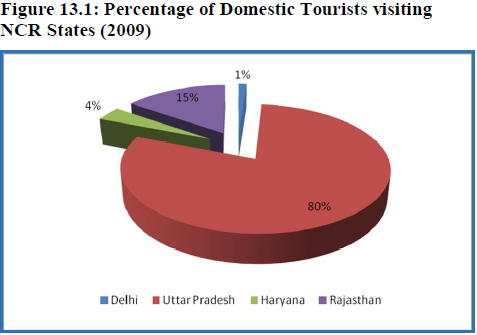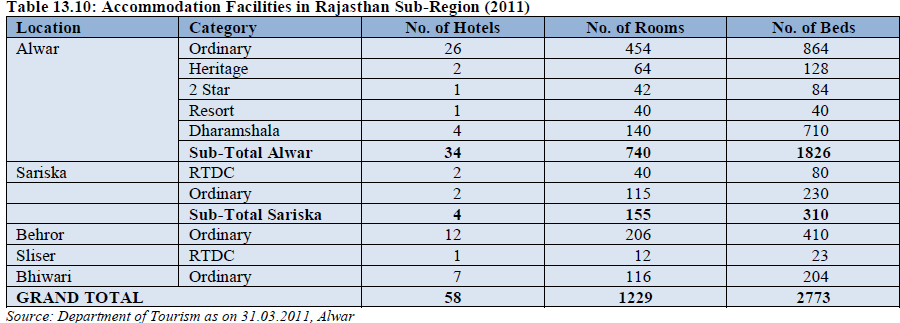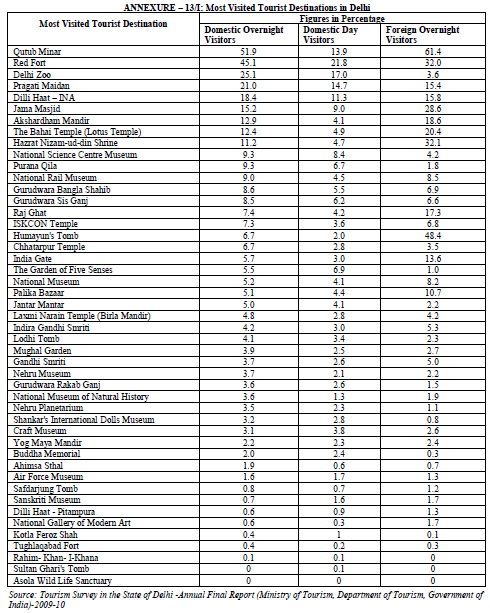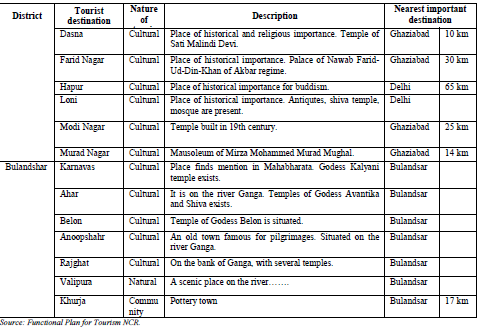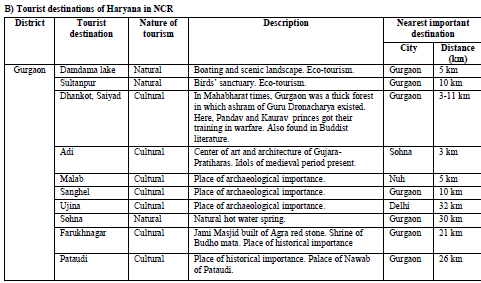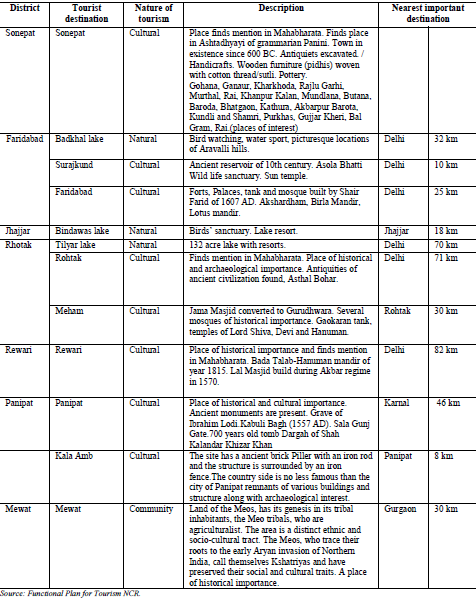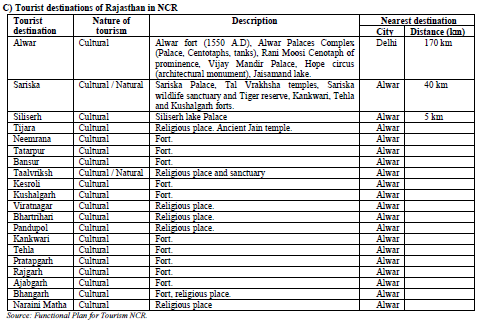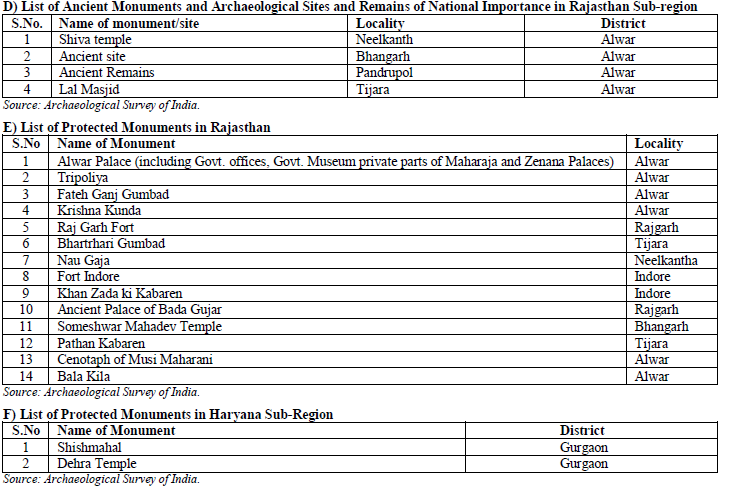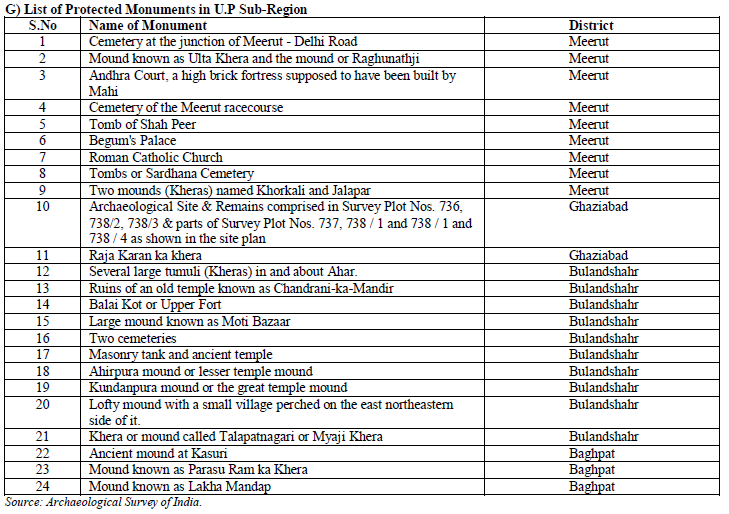National Capital Region (India): Heritage and Tourism
This article has been sourced from an authoritative, official readers who wish to update or add further details can do so on a ‘Part II’ of this article. |
Contents |
The source of this article
Draft Revised Regional Plan 2021: National Capital Region
July, 2013
National Capital Region Planning Board, Ministry of Urban Development, Govt. of India, Core-4B, First Floor, India Habitat Centre, Lodhi Road, New Delhi-110003
National Capital Region Planning Board
National Capital Region (India): Heritage and Tourism
BACKGROUND
Tourism plays an important role in promoting faster, sustainable and more inclusive economic growth. It has better prospects for promoting pro-poor growth than many other sectors. The XIIth Five Year Plan has estimated to creation of 78 jobs per million rupees of investment in the travel and tourism as compared to 45 jobs in the manufacturing sector.
The NCR is endowed with a vast and multilayered history of diverse cultural heritage and natural resources with prospects to develop the Region a globally competitive tourism destination. The Region has ancient cultural sites of international, national, regional, and local significances. The natural expanse of the NCR is diverse in terms of vast forest areas; hills and ridges part of Aravalli ranges; rivers, large wetlands; arid hinterlands which are home to large number of flora and fauna. All these tourism resources attract a large number of domestic and international tourists in NCR (Map 13.1).
EXISTING HERITAGE SITES IN NCR
Man-made Heritage
There are 258 centrally protected monuments protected by Archaeological Survey of India (ASI) and 20 State protected monuments protected by State Archaeological Departments in the constituent States of NCR (Table 13.1). NCT Delhi has the highest number of Centrally protected monuments (166) followed by Haryana Sub-Region (63) and Uttar Pradesh Sub-Region (26). State protected monuments are more in Rajasthan Sub-region. However, there are a larger number of unprotected monuments. The unprotected monuments are those monuments, which have not yet been identified as culturally valuable, but may be good examples of cultural/historical heritage that is being slowly obliterated is traditional urbanscape. This is because neither of the Centre/State Archaeological Protection Acts recognizes them as possessing heritage value. These areas may or may not contain individual buildings, which qualify for protection, but when considered as an ensemble, they represent valuable heritage worthy of conservation.
In addition to the above legally protected monuments, the Indian National Trust for Arts and Cultural
Heritage (INTACH) has also listed 1,627 monuments and 26 conservation areas in the region that need to
be protected. As much as 74 percent unprotected monuments are located in Haryana Sub-region. State
wise details are given in Table 13.2. These heritage sites need to be identified and marked for appropriate
protection.
SUB-REGION WISE MAN-MADE HERITAGE SITES
13.3.1 NCT-Delhi
In 1911, Zaffar Hasan an historian had identified 1,321 monuments in Delhi which have also been reflected in MPD-2001. Over the years this number, according to INTACH, reduced to 1,208, which included 166 centrally protected monuments by ASI under ASI Act, 1958 The Municipal Corporation of Delhi had notified these monuments as heritage buildings. Besides, State Government is in the process of notifying about 150 monuments in NCT Delhi. The Government of NCT –Delhi is also in the process of enactment of a Heritage Building Act for preservation of the buildings, which are more than 100 years old. In fact distinctive historical pattern of Delhi has a large number of highly significant heritage resource mainly dating from 13th century onwards. Heritage typologies include archaeological sites, fortifications, citadels, religious complexes, tombs, historic gardens, water harvesting structures, historic walled city etc.
13.3.2 Rajasthan Sub-Region
There are four centrally protected monument in Rajasthan Sub-Region listed below in Table 13.3.
Box 13.1
Monuments
The Ancient Monuments and Archaeological Sites and Remains Act, 1958 defines an ‘ Ancient Monument ’ as follows:- Ancient Monument means any structure, erection or monument, or any tumulus or place of interment, or any cave, rock-sculpture, inscription or monolith which is of historical, archaeological or artistic interest and which has been in existence for not less than 100 years and includes—
i. Remains of an ancient monument,
ii. Site of an ancient monument,
iii. Such portion of land adjoining the site of an ancient monument as may be required for
fencing or covering in or otherwise preserving such monument, and
iv. The means of access to, and convenient inspection of, an ancient monument;
“Archaeological site and remains” means any area which contains or is reasonably believed to contain
ruins or relics of historical or archaeological importance which have been in existence for not less than one
hundred years, and includes—
Such portion of land adjoining the area as may be required for fencing or covering in or otherwise
preserving it, and
The means of access to, and convenient inspection of the area;
Source: Archaeological Survey of India
In addition, there are 14 monuments that are on the State protected monuments list under the Rajasthan Monuments, Archaeological Sites and Antiquities Act, 1961. Natural heritage sites in the Sub-region are given in Table 13.4.
13.3.3 Uttar Pradesh Sub-Region
There are 26 centrally protected monuments under Archaeological Survey of India (ASI) Act of which 10 each are in Meerut and Bulandshahr District, 3 in Baghpat, 2 in G B Nagar and 1 in Ghaziabad. There are two State protected sites (Baleshwar Nath Mandir and Begum Samaru Mahal in Meerut) under the Directorate of Archaeology, UP. Besides these legally protected monuments, the Indian National Trust for Arts and Cultural Heritage (INTACH) has listed a large number of monuments worthy of receiving protection. In addition, there are several ancient and medieval archeological sites primarily located in Meerut which are of interest to both the scholars as well as the tourists.
Natural heritage There are a large number of Natural heritage sites in the Sub-region, viz. Hastinapur Sanctuary, River Yamuna, Ganga, Wetland, etc.
13.3.4 Haryana Sub-region Haryana Sub Region is abundant in built and natural heritage sites associated with mythology and history in the region. Built Heritage includes buildings, artifacts, structures, areas and precincts that are of historic, aesthetics, architectural or cultural significance, precincts of the environment significance or scenic beauty etc.
Natural Heritage: Haryana Sub region is gifted with a number of natural sites which illustrate the bio diversity of the Sub Region. It includes Hilly areas: Aravallis at Gurgaon, Faridabad and Mewat River Systems, Yamuna Wetland Systems, Damdama Lake, Gurgaon, Sohna Lake / Hot water Spring, Gurgaon Badkal and Surrounding Lakes, Faridabad Kotla Dhar Lake, Mewat ,All existing man-made and natural water bodies including village ponds ,Special Protection Areas: Sultanpur national Park – Gurgaon, Bhindawas Birds Sanctuary – Jhajjar.
Legal instruments for regulations of Heritage areas. Recent amendments in the Ancient Monuments and Archeological Sites and Remains (Amendment and Validation) Act,2010 has made it mandatory to identify the prohibited and regulated areas around centrally protected monuments (Box 13.2) this will help in regulating the surrounding areas of protected monuments.
TOURISM
Tourism involves a number of activities, services and industries comprising of transportation, accommodation, eating and drinking establishment, retail shops, entertainment business and other hospitality services provided to individuals or tourist groups traveling for leisure, business or other purposes. Considerable development of tourism has taken place in Sub-regions through the respective Department of Tourism.
The respective State Departments have been very active and have developed a
variety of tourist places in their Sub-Regions. Tourism has the potential to stimulate other economic
activities through forward and backward linkages. The tourism policy should be pro-active to diversify
the options available to the tourists and activities through the development of smaller tourism circuits so
that tourists have wider options to choose from a sample of the diverse range of tourism sites available
within the region.
TOURIST FLOW IN NCR
In 2009, the Delhi Airport received 31.8% of the total 13.71 million international tourists visiting India. Delhi had the highest number of international tourists visiting NCR. About 42% of the total foreign tourists visited the tourist places in Delhi, 32% in Uttar Pradesh, 23% in Rajasthan and 3% in Haryana. In respect of domestic tourists visiting NCR, Uttar Pradesh (80%) attracted a large share followed by Rajasthan (15%), Haryana (4%) and Delhi (1%) (Table 13.5 and Figure 13.1 & 13.2).
Box 13.2
PROHIBTED AND REGULATED AREAS (Section 20 A and 20 B) Every area, beginning at the limit of the protected area or the protected monument, as the case may be, and extending to a distance of one hundred meters in all directions shall be the prohibited area in respect of such protected area or protected monument.
Provided that the central Government may, on the recommendation of the Authority, by notification in the Official Gazette, specify an area more than one hundred meters to be the prohibited area having regard to the classification of any protected area.
REGULATED AREA: Every area, beginning at the limit of prohibited area in respect of every ancient monument and archaeological sites and remains, declared as of National importance and extending to a distance of 200 meters in all directions shall be regulated area in respect of every ancient monuments and archaeological sites and remains.
HERITAGE BYE-LAWS(Section 20 E(1) The competent authority, in consultation with the Indian National Trust for Arts and Cultural Heritage, being a trust registered under the Indian Trusts Acts, 1882, or such other expert heritage bodies as may be notified by the Central Government, shall prepare heritage bye-laws in respect of each protected monument and protected area.
The Heritage bye-laws include matters relating to heritage controls such as elevations, facades, drainage systems, roads and service infrastructure (including electric poles, water and sewer pipelines. The Central Government shall, by rules specify the manner of preparation of detailed site plans in respect of each protected area or protected monument or prohibited area or regulated area, the time within which such heritage bye-laws shall be prepared and particulars to be included in each such Heritage bye-laws. Source: The Ancient Monuments and Archaeological Sites and Remains (Amendment and Validation) Act, 2010
13.5.1 NCT Delhi
The National Capital Territory of Delhi, which is strategically located at the centre of the region comprehensively reflects ancient past with contemporary cosmopolitan cultural expressions. The capital city of Delhi is rich in culture, architecture and human diversity, varied history, monuments, museums, galleries, gardens and exotic shows. The city houses the diverse range of natural and man-made built assets form Indraprastha (rule of Pandavas of Mahabharata fame) rein to contemporary British rule. The National Capital has numerous edifices of cultural, archaeological, historical, architectural, educational,
economic, social and natural significances in forms of forts, monuments, tombs, historical precincts, cultural landscapes, religious structures, historical settlements, colonial architecture, natural parks, recreational facilities, urban cultural centres, etc. that is why it attracts a large number of tourists and visitors to the city. Delhi is the potential hub of connectivity and destination to most of the tourist circuit and destinations in the Northern Plains as it strategically connects to rest of the pan northern areas and popular and remote destinations by virtue of its logistical facilities and compatible visitor infrastructure.
Delhi is already an established destination of the golden tourism triangle of Delhi-Agra-Jaipur. Delhi also acts as international and national tourism transit destination for the tourists bound to Jammu & Kashmir, Rajasthan, Uttrakhand and Himachal Pradesh, thus establishing it as the tourism gateway to northern India with immense potential and opportunities which can be exploited for benefit of the NCR. In the NCT Delhi, the following two circuits have been identified for integrated development. Circuit 1: Heritage circuit covering the heritage monuments and structure in the NCR Circuit 2: Religious circuit, covering the important places of worship such as Akshardham, Bahai Temple, Jama Masjid, Nizamuddin Dargah, Gurdwara Bangla Sahab, etc.
In 2009-10 majority of domestic as well foreign tourists visited archaeological protected monument like
Qutub Minar and Red Fort area.Both these monuments as well as Humanyun’s Tomb are the rich cultural
Heritage in the city and are listed as World Heritage Monuments by UNESCO.Breakup of tourist sites
visited by the domestic as well foreign tourists is given in Annexure 13/I.
Tourist destination like Purana Qila, Jantar Mantar, Safdarjung tomb, Bahai temple, Raj Ghat, Lodhi
Garden etc. are also frequently visited by the domestic and foreign tourists as these sites have good
supporting infrastructure .
13.5.2 Uttar Pradesh Sub-Region Several areas of the State included in NCR are of religious, historical, cultural and archaeological importance. Most of these destinations find mention in the epic Mahabharata. The Garh Mukteswar is the closest point to reach the holy River Ganges from the National Capital at a distance of 100 km. Tourist destinations noted in the state within NCR are listed in Annexure 13/I.Tourists visiting some of the destinations in Uttar Pradesh Sub-region are given in Table 13.6.
A. Religious sites
There are 39 religious/ pilgrimage sites which are visited by various religious groups. Domestic religious tourism accounts for the maximum tourist traffic. These sites have low spending domestic tourist traffic. These sites face the problems of encroachment, poor conservation, maintenance, tourist amenities, nonavailability of signages and parking during festivals.
B. Eco -Tourism Sites Various ecologically sensitive sites of the UP Sub-region are divided into (i) 1 Special Protected Area (ii) 3 Eco-sensitive Reserved Forest Areas and (iii) River Systems (Ganga, Yamuna, Hindon), Wetlands and Water bodies. The entire zone is ecologically protected and provides an excellent site for mini tours and recreational trips in the natural environment.
In Uttar Pradesh, the following four tourism circuits have been identified for integrated development.
Survey of the Ministry of Tourism held in 2005-2006 reported few tourists visited the destinations in the districts of Uttar Pradesh included in NCR.
A. Tourists Infrastructure in UP Sub-region
In UP Sub-region, maximum number of tourist interest sites are in Meerut district especially in Meerut town. The number of tourists visiting these tourist destinations and fairs during festivals are showing an increasing trend for both domestic and foreign tourists. Most of the tourists from foreign countries come to Sardhana to visit Begum Samru church and Hastinapur.Tourist accommodation mainly includes Hotels, Bed and Breakfast facilities, Dharamshalas and tourist Bungalow in the Sub-region. Districtwise details of accommodation facilities is given in Table 13.8.
13.5.3 Rajasthan Sub-Region
The tourist places in Alwar district are listed in Annexure-13/I. Alwar District (RSR) has a strategic location for tourism. The sub- region is situated within the popular and famous Golden Triangle Circuit connecting Delhi – Jaipur – Agra. According to tourist estimates, about 60% of international tourists visiting India come to these three places. Moreover, the Perspective Plan for Tourism in Rajasthan – 2021, suggests, Alwar (RSR) as part of Brij – Mewat Circuit, which is for wildlife tourism enthusiasts. It includes Alwar-Sariska-Deeg-Bharatpur- Dholpur-Karauli-Sawai Madhopur. Tourism statistics available from the Department of Tourism, GoR, show that the main centres for tourism in the sub-region are Alwar, Sariska, Siliserh and Behror. Tourist arrivals in these four centres are shown in Table 13.9 below.
Based on the tourist arrivals, the above four tourist destinations are ranked among the major tourist destinations in Rajasthan state. From the above table it is clear that Alwar is the most visited destination in the sub-region followed by Sariska.
A. Accommodation In the Rajasthan sub-region, Alwar Town has a well-developed hotel accommodation. Alwar Town is also the predominant destination of choice due to its convenient location in respect of the tourism destinations as well as the availability of hotels and guest houses for tourists. Alwar Town offers a wide range of accommodation options for tourists in the form of hotels, guest houses, dharmshalas, etc.
The tourism accommodation in the area ranges from heritage hotels offering luxury stay and services to budget hotels. The room availability in all the different classes of hotels and guest houses is 1229 and the availability in number of beds is 2773 (Table 13.10).
13.5.4 Haryana Sub-region
The Haryana sub region has a mix of tourism experiences, combining both history/nature/culture with recreational and entertainment facilities. The Sub-region has many listed national monuments, archaeological sites of Harrapan civilization significance and Sarswati Valley Civilization, natural wetlands, reserve forests and sanctuaries, recreational zones, adventure experiences, etc. supported by world class urban experience in the form of shopping malls, entertainment facilities, civic amenities, multimodal transport oriented development, etc. Haryana tourism is one of the successful entrepreneurship examples in public-private partnerships in creating tourism facilities and amenities.
The
forte of Haryana’s tourism development has been highway tourism, wayside tourism, night-halt/motel
tourism, recreational/ leisure centres, etc. which are the strengths that give impetus to non-itinerary
scheduling of the tourists and visitors
In Haryana Sub-Region, the following tourist circuits have been identified
Circuit 1: Kalka-Panchkula-Naraingarh-Yamuna Nagar-Kurukshetra-Thanesar-Pehowa-Panipat
Circuit 2: Rohtak-Meham-Hansi-Hissar-Dabwali
Circuit 3: Surajkund Damdama Lake-Faridabad (Badhkal Lake)-Palwal
During 2011-12, about 31.8 lakh tourists visited Haryana Sub-Region which included 95% domestic and
5% foreign tourists (Table 13.11).
POLICIES AND PROPOSALS
13.7.1 Protection of Man-made Heritage Sites
Central and State Legislations ensure physical protection of the buildings/sites but they have not been able to control the development of the land appurtenant to the actual protected area. This is where it is possible to employ the instrument of the Town and Country Planning Legislation to protect the area around the protected monument. In view of this, following policies/strategies are proposed:
i) The listing of monuments and conservation areas of all the towns/districts in NCR should be
completed on priority basis. All the centrally protected, state protected and listed buildings should be
identified with their footprints on the Master/Zonal Plans of each town and in the District Plans in the
region. Specific requirements for their protection should be highlighted in the said plans and may
vary according to their level of significance. A distinction needs to be made between the legally
protected buildings and the 'listed' buildings. The 'listed' buildings do not require the same level of
scientific protection as the centrally and state protected monuments.
ii) Town and Country Planning Legislations of the constituent States have provisions for the
development of "Special Areas". Each State should use this instrument to declare the area around the
protected monuments to be special areas and prepare area level plans for an area covering 300 metres
around it. These plans should clearly indicate the nature of development, permissible and nonpermissible
activities within this area in conformity with the prescriptions provided in the central and
state archeological protection legislations.
iii) The respective departments of archaeology should indicate where they reasonably expect to find
underground ruins, and these areas should be duly identified in the Master Plan for each town and the
respective district level plans. Buildings proposed to be constructed in these areas should require a
no-objection certificate from the relevant departments of archaeology before the building plans are
sanctioned.
iv) In order to implement these policies, if any amendment is required in the Town and Country Planning
Act of the constituent States, it should be done.
13.7.2 Protection of Natural Heritage Sites
i. All the identified areas of natural heritage should be protected in terms of land use and pollution control in the vicinity to ensure the protection of biodiversity and urban ecosystems. Afforestation with right type of species and control of growth of monoculture should be taken up in hilly areas.
ii. Right type of agricultural practices including social forestry, energy plantation and agro-forestry would go a long way to improve the natural environment.
iii. The enforcement of the prohibition, directions notified by the Ministry of Environment and
Forests, Government of India dated 07.05.1992 [under Section 3(1) and 3(2) (v) of the
Environment Protection Act, 1986 and rule 5(3) (d) of the Environment (Protection) Rules, 1986
restricting certain activities in specified area of Aravalli Range which are causing environmental
degradation in the region] should be ensured while taking up developmental activities in the
region. A special Conservation Plan for the above notified areas should be prepared by the
respective State Governments/Authorities.





